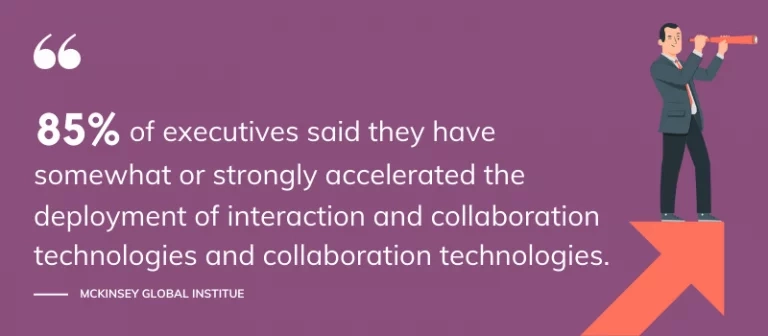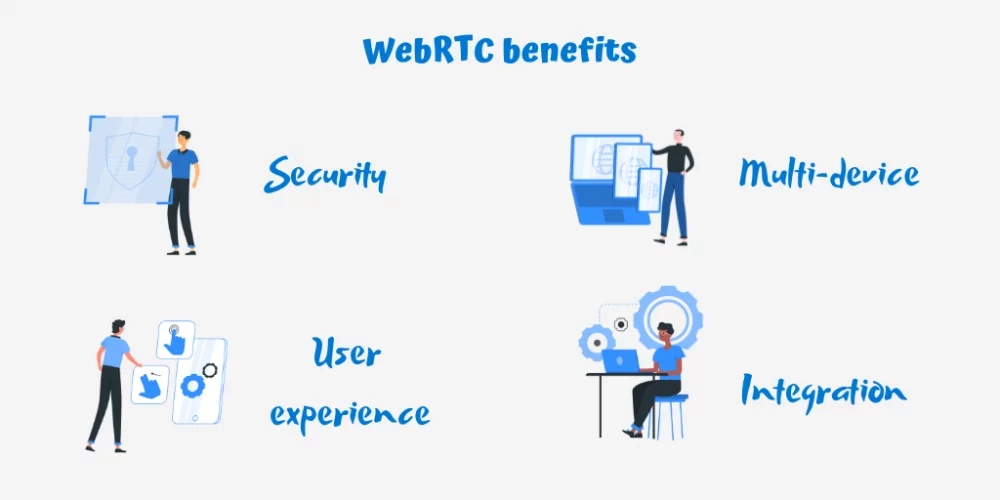Benefits of WebRTC solutions for video conferencing

Video conferencing is a communication tool that companies have been using for many years to connect geographically distant parties. Until a few years ago, the use of video conferencing required the presence of a hardware and software infrastructure that imposed significant requirements. With the emergence of WebRTC technology, these barriers disappear and make it possible to democratize the use of videoconferencing, making it no longer exclusively limited to internal use. First modest in companies, the adoption of WebRTC-based technologies accelerated considerably during the health crisis linked to the COVID-19 epidemic. The use of WebRTC for multiple use cases, including emerging uses, has demonstrated the benefits of this technology and has kept it in the forefront of business uses.
What is WebRTC?
Video conferencing and its uses for remote collaboration and expertise have been around for some time. A few years ago, the solution to collaborate remotely through video conferencing consisted of installing software or plugins on a PC or applications on a smartphone, which required an effort from the users and imposed the use of complex protocols for the solution providers.
In 2011, Google teamed up with Internet players to publish the WebRTC (Web Real Time Communications) protocol. This protocol allows video and audio communications to be established directly between web browsers, without installing any software, plug-ins or applications. It has the advantage of being compatible with all browsers on the market, regardless of the device on which it is used.

This technology is now mature and has become a Web communication standard, particularly due to an acceleration in usage linked to the COVID-19 pandemic. Indeed, a recently published McKinsey Global Institute study concluded that out of 800 executives from eight countries across all industries, 85% reported “somewhat or strongly accelerating” the deployment of employee interaction and collaboration technologies, including, of course, video conferencing.
WebRTC technology presents countless opportunities for large enterprises, due to the variety of possible use cases (enterprise collaboration, live shopping, customer support, after sales service, telemedicine).
The advantages of WebRTC

Security
The use of real-time communication applications is always susceptible to risks, especially the access to data during transmission. Data encryption makes it impossible for a third party to determine the content of the communication flow. Only users with access to the secret encryption key can decode the communication streams. Encryption is a mandatory feature of WebRTC, all streams and media sent over WebRTC are securely encrypted using standard and well-known encryption protocols (DTLS and SRTP). All these factors make the chances of hackers accessing your data minimal. Even if they do intercept it, they will have hardly any possibility to decode it and use it.
WebRTC also introduces the requirement to establish communications exclusively from a secure connection. All exchanges must be HTTPS (Hypertext Transfer Protocol Secure) compliant. This means that not only must the page be secure for a connection to be established, but the server you are communicating with from that page must also be secure.
Another advantage of WebRTC in terms of security is that it allows you to communicate without installing any software, applications or plug-ins. Any such installation exposes you to security risks. As for any software or application, when you forget to update it or when it is not properly maintained, you are more easily exposed to attacks. Conversely, the major web browser vendors take security very seriously. When a security risk is detected, they develop and deploy patches very quickly, often much faster than most software vendors. Conversely, the major web browser vendors take security very seriously. When a security risk is detected, they develop and deploy patches very quickly, often much faster than most software vendors. The major browsers also offer automatic software updates. This helps address any potential threats and mitigate security risks.
Multi-device compatibility
Another benefit of WebRTC is that communications can be established on any type of device. Whether it is on a computer, a tablet, a smartphone or a connected object, the only requirement is that the device is provided with a web browser. There is no need to buy specific equipment, no installation and maintenance costs are required.
User experience
With WebRTC and the downloading requirement gone, companies can provide their users with a more seamless customer experience. With WebRTC and the downloading requirement gone, companies can provide their users with a more seamless customer experience. When communicating with external parties (customers, service providers, etc.), there is no longer a need to verify that the application or software is properly installed, that its version is up to date, or even worse, to wait for the contact to access a service portal to download the necessary software or application before being able to start the communication. WebRTC allows you to launch the web browser and connect via video with a single click.
Using WebRTC on smartphones also allows you to switch from a traditional phone call to a video call with a single click and without having to hang up. In the context of customer relationship use cases, this advantage helps reassure the customer and avoid friction points.
Ease of integration
WebRTC works on well known protocols and standards. This means that solutions based on this technology can be easily integrated with other technologies and software. This is especially important when you need to integrate a video conferencing or video calling solution with existing business processes and information systems.
What use cases is WebRTC good for?
Apizee’s business solutions are based on WebRTC technology. This technology allows us to respond to a multitude of use cases. Here are some examples:
Customer relations
WebRTC video calling solutions improve the customer experience during the two moments of truth in customer relations, sales and customer support.
During the sale, WebRTC makes it possible to use video communication to advise a customer from a web portal in a very simple way. The customer can initiate a video call directly from a company’s website. It is also possible to organize remote individual shopping appointments. In this case, it is enough to send an invitation by email or SMS to the customer with a connection link. A click on the link is enough to launch the call.
In the context of customer support calls, WebRTC allows to make diagnoses and to guide the customer remotely to solve problems more quickly by saving many technician trips.
Industrial Maintenance
WebRTC technology has helped introduce video-expertise and video-assistance in the industrial services sector over the past few years. On-site technicians may face a wide variety of difficulties and not have answers for all situations. Thanks to WebRTC, they can call on experts remotely, whether from a smartphone, a tablet or in hands-free mode, even if thousands of km separate the two parties.
Telemedicine
The telemedicine market and teleconsultation services have grown exponentially in recent years. One of the most important aspects of a teleconsulting solution is the ability to quickly connect patients and physicians. This is not always possible when using technology that requires the download and installation of an application or software. With WebRTC, users can initiate a call instantly and easily. By clicking on a link or answering an invitation, physicians and their patients can connect in seconds. On the other hand, these are uses that must meet strong security requirements to avoid exposing sensitive personal data to security breaches. WebRTC is the answer to these major issues.
Insurance
In the insurance sector,WebRTC technology is used in particular for remote claims management. The video call allows loss adjusters to handle small claims without having to travel. This use allows insurance companies to quickly reimburse their clients and reduce the cost of travel for adjusters.
Enterprise Collaboration
WebRTC has created new opportunities for team collaboration. With WebRTC, users have access to real-time audio and video conferencing on browsers without any installation. This technology democratizes video conferencing for team collaboration by simplifying integration, reducing costs, and ensuring browser interoperability, without neglecting corporate security requirements.
Real-time communication solutions based on WebRTC technology can truly transform your relationship with customers and business collaboration. At Apizee we are committed to supporting you in the deployment of this type of solution within your information system. Contact us to learn more or to receive a demo, we are ready to help you meet this challenge.
I want to take up the challenge!
Read also:
- How to transform the customer experience in insurance thanks to remote loss adjustment
- Video call, the new communication channel for brands
- Why should be using visual assistance in your customer service?
- 10 reasons to use real-time video assistance in the industry
- Video conferencing solutions: security comes first



